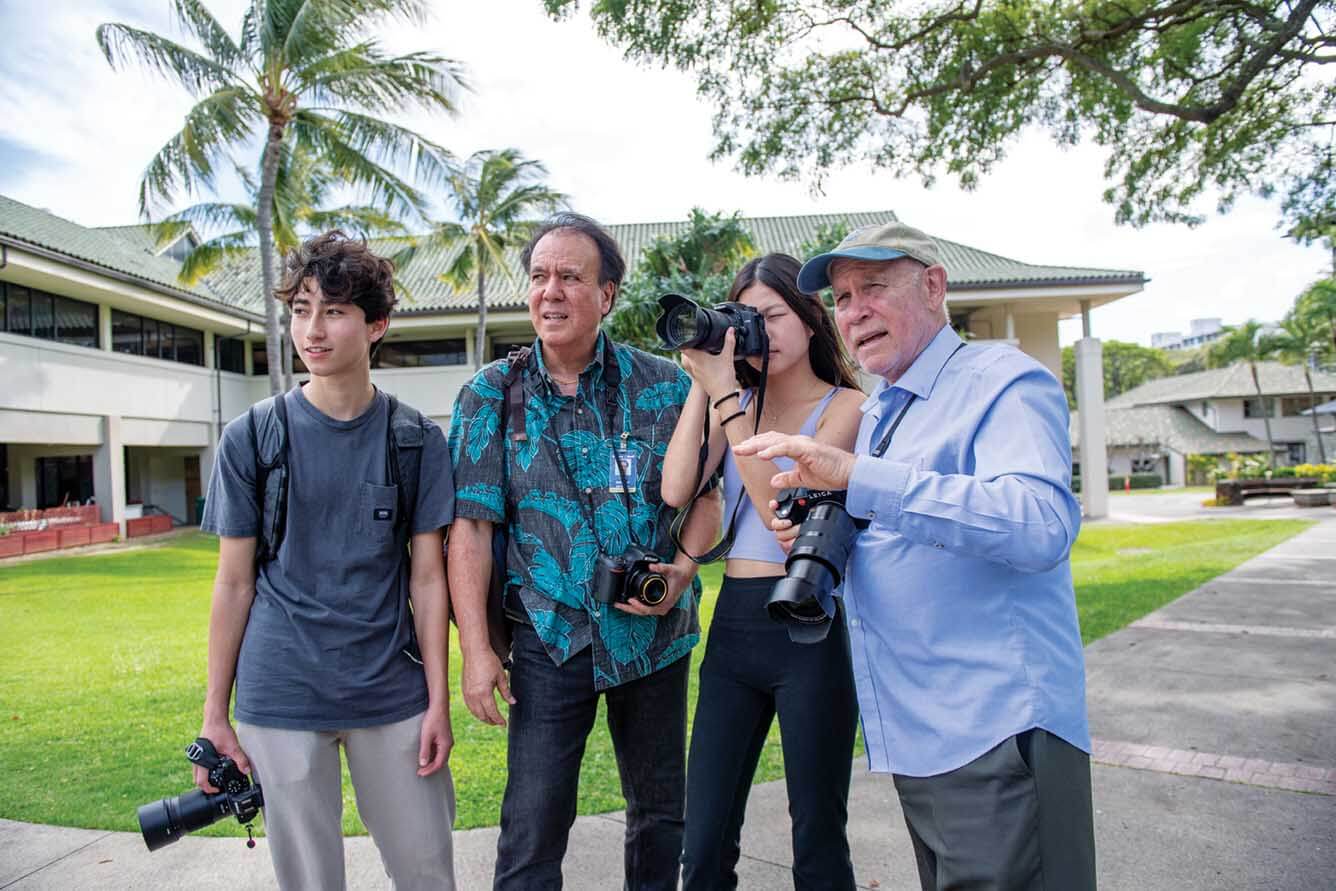Above: Steve McCurry in the field with photography students in Alex Selarque’s class.
Related: The World as a Profound Invitation: Photographer Steve McCurry Visits Punahou
When Alex Selarque found out iconic photographer Steve McCurry would visit Punahou in March, he sprang into action. “There is nobody like him,” says Selarque, who has been teaching visual arts at Punahou since 1996. “He has true command of his craft and is one of the most highly regarded photographers in the world.”
He quickly began brainstorming ways in which McCurry’s visit could be leveraged to edify the skills of students in his Advanced Photography class. It would be a tall order for the young photographers. McCurry’s use of light and color are unrivaled – not to mention his keen ability to create portraits that capture a subject’s essence, plight and culture.
Imitating technique is one thing. It can be achieved through careful examination of a master’s work and enough diligence. But the intangible gift of rendering the complexity of a subject and connecting the viewer to places and cultures far away, which is omnipresent in McCurry’s work – that’s where the real rub lies.
The class was up for the challenge. “His visit was an inspiration to design an assignment specific to the work of the master photographer,” Selarque says. The students began by selecting one of McCurry’s water-themed images, imparting insight into human experiences in places like Madagascar, Venice and Myanmar. As an homage or master study, the students were asked to take inspiration in the photo they connected with: mirroring the composition, color and lighting. Off they went to the field, trying to replicate the work of a legend.
The students rose to the occasion, producing a mosaic of photographic work – influenced by a master but conceptualized and executed through the students’ artistry, creativity and enterprise. They had the opportunity to present their work in class. “The highlight of this project was having McCurry analyze and comment about their master study,” Selarque says. “McCurry is an artist that uses photography to capture people, places and their relationships. This allowed students to discover a deeper way of capturing portraits and landscapes with special attention to the color and light.”
The following lays out the beautiful interpretations from some of the intrepid student photographers – and their reflections on how they were inspired and what they learned about the human spirit and diverse cultures from this unique project.
Emma Fuleky ’27

I have been fascinated with reflections ever since I was young, which is what drew me to this specific photo from Mr. McCurry. Through my interpretation of his work, I tried focusing on color.
When I took this shot, I expected everything to wash together. There was so much green around me but the skin color emanating from the subject in my photo didn’t pop enough to create a contrast. However, I took photos from different vantage points hoping that the sun would hit just at the right angle, making the pattern in the water just right.
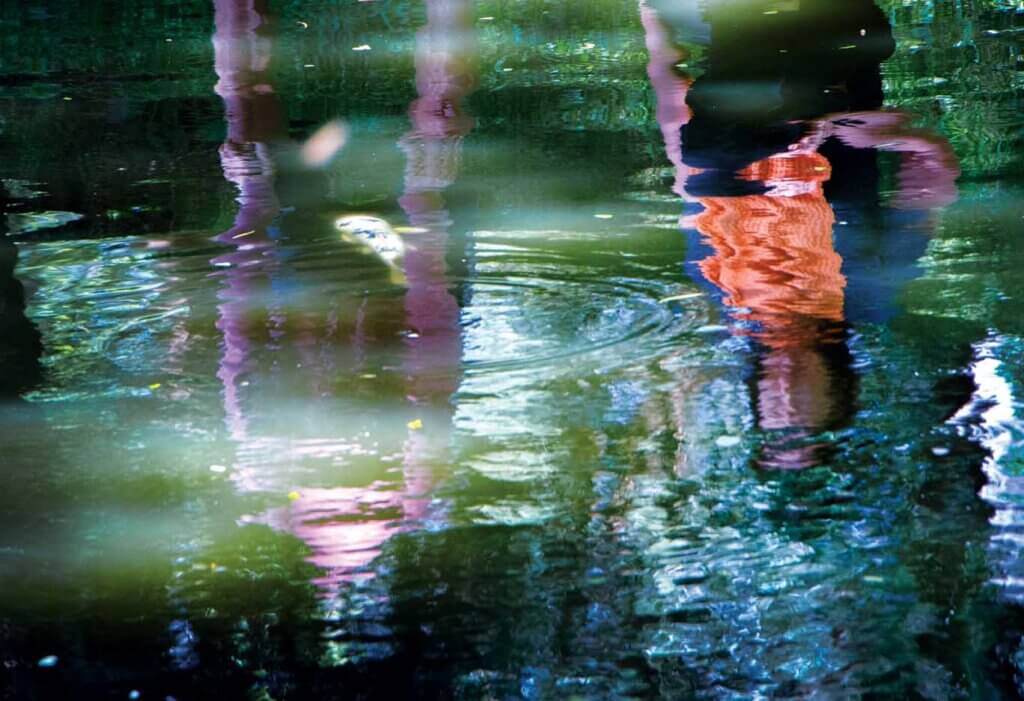
As a young photographer, I learned that it is not the big picture that you have to look at but the small details in everyday life. The subject in a photograph, whether you see their face or not, has the drive to move forward even when encountering adversity. This drive that you see in each person also gives me inspiration to move forward. When I face an obstacle, I think about the details around me and see how they may pose an opportunity rather than a challenge.

Two fishermen reflected on Lake Inle. Lake Inle, Burma / Myanmar, 2011.
Dreamlike reflections of two fishermen on Inle Lake, a highland freshwater lake in Myanmar where fishermen row with one leg amongst floating gardens and houses built on stilts.
Jordan Quan ’25
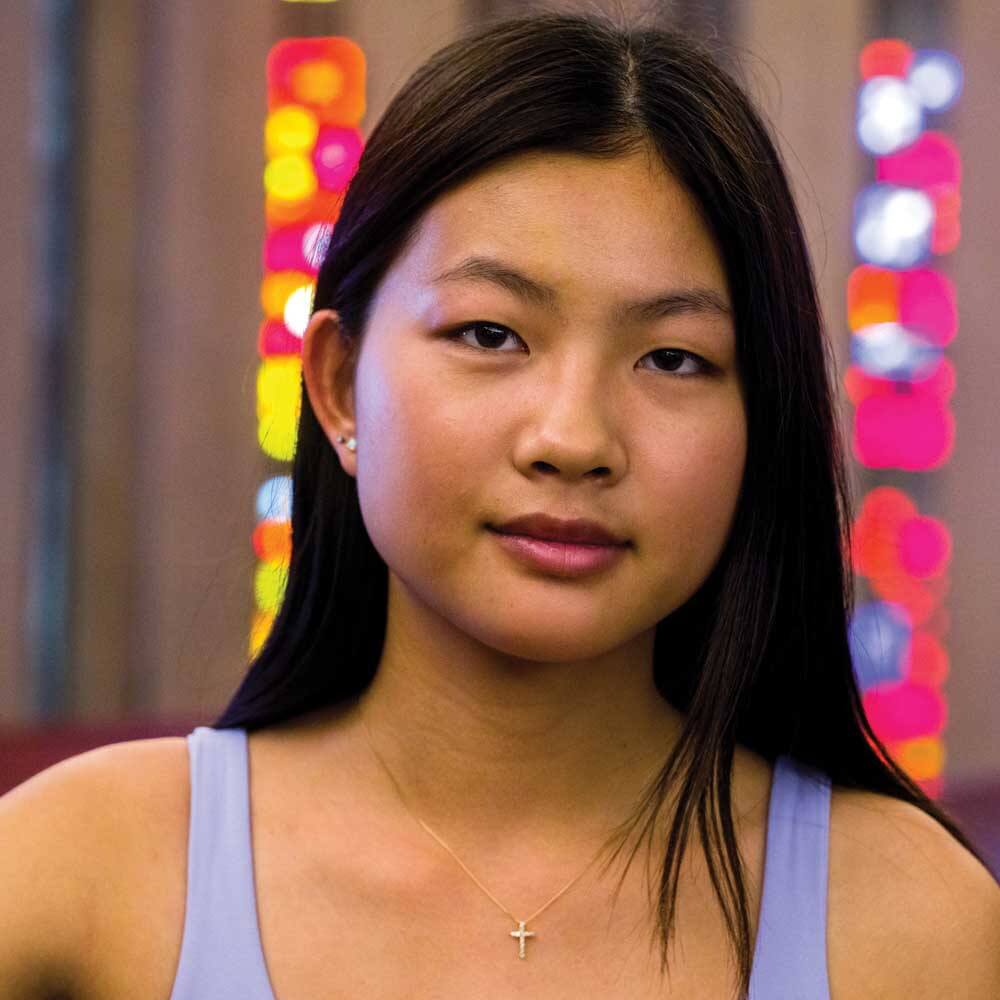
What drew me to the Steve McCurry photo I selected was the unique use of color. I saw a beautiful opportunity to capture and share the similarities and differences between Hawai‘i and Madagascar – and how even worlds apart, we shared a common ground. I saw how the woman in this photo walked and presented herself, all the emotions I wanted to convey in my photograph.

The main technical aspect I was trying to emulate was the specific colors, lighting and composition of the subject. I accomplished this by choosing a time of day that would best replicate Mr. McCurry’s use of the sun and incorporated my love of sunsets. Because I already had an image in my head of how to compose this photo, I knew exactly where I wanted to take it.
Through Mr. McCurry, I learned how to be comfortable with a camera in public and how to find the beauty in what I would usually consider “ordinary.” I learned to trust my instincts and that framing your subject is incredibly important to convey the message intended. One slight movement in any direction can truly make or break the photo!
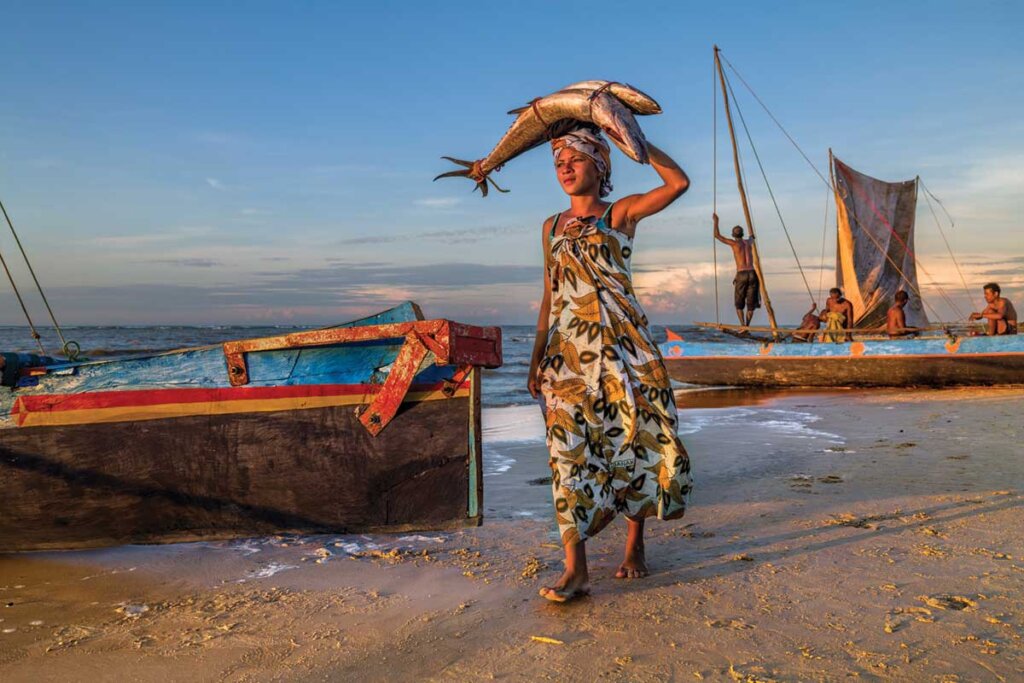
Woman carries fish on beach. Morondava, Belo Sur Mer, Madagascar, 2019.
Belo Sur Mer Beach in Madagascar is renowned for its pristine white sands, turquoise waters, and vibrant coral reefs, offering a picturesque paradise for beach lovers and snorkelers alike. Nestled amidst lush tropical surroundings, this idyllic coastal retreat beckons travelers seeking tranquility and natural beauty off the beaten path.
Nanea Allen ’24

Looking through Steve McCurry’s photos, I was drawn by their bright color and simplicity. They reminded me of sunsets on the beach with my friends. When given the assignment to interpret one of his photos, I was trying to showcase the use of similar color and lighting. I studied his photos to determine the best location and time of day to shoot my work.
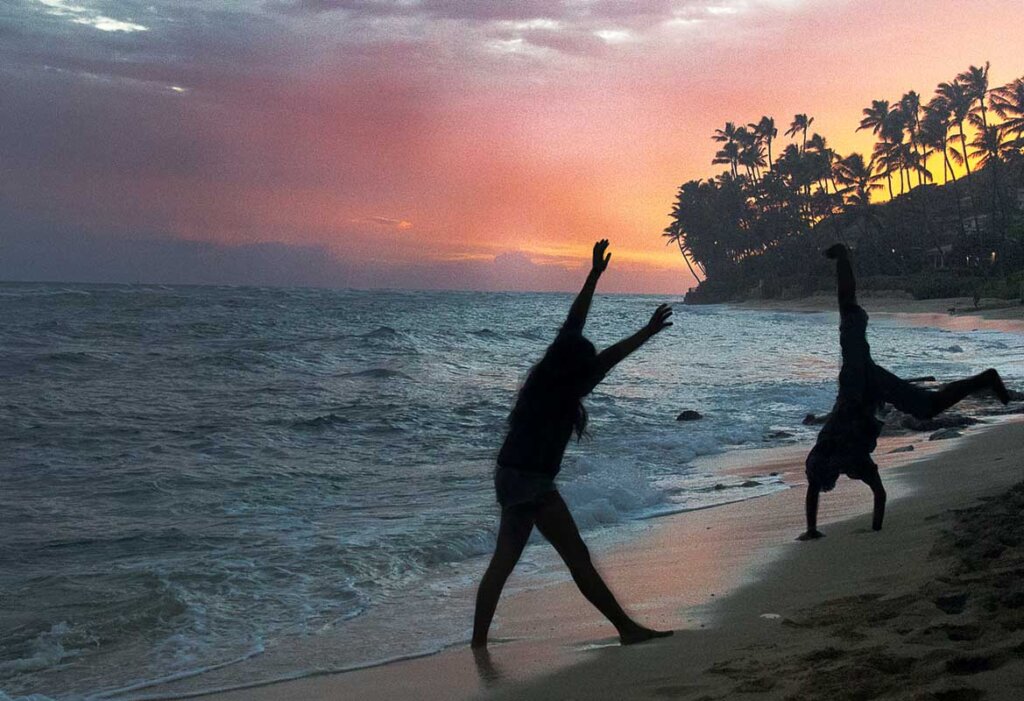
Through this experience, I learned that perspective is a vital element in this form of art – not focusing on what is wrong with a photograph, but rather, seeing the aspects that are unique and beautiful. I now know that even an accident can become a focal point and a topic of conversation. At first, I struggled when trying to recreate his work because I was so focused on making it exactly like his. But I began to realize that there is beauty in personal interpretation; a sense that my work could be just as meaningful and impactful.
Mr. McCurry taught us that it is important to have a purpose when you shoot and to take the time to get just the right moment. I think that is a valuable lesson in both photography and life; patience is the key to greatness.
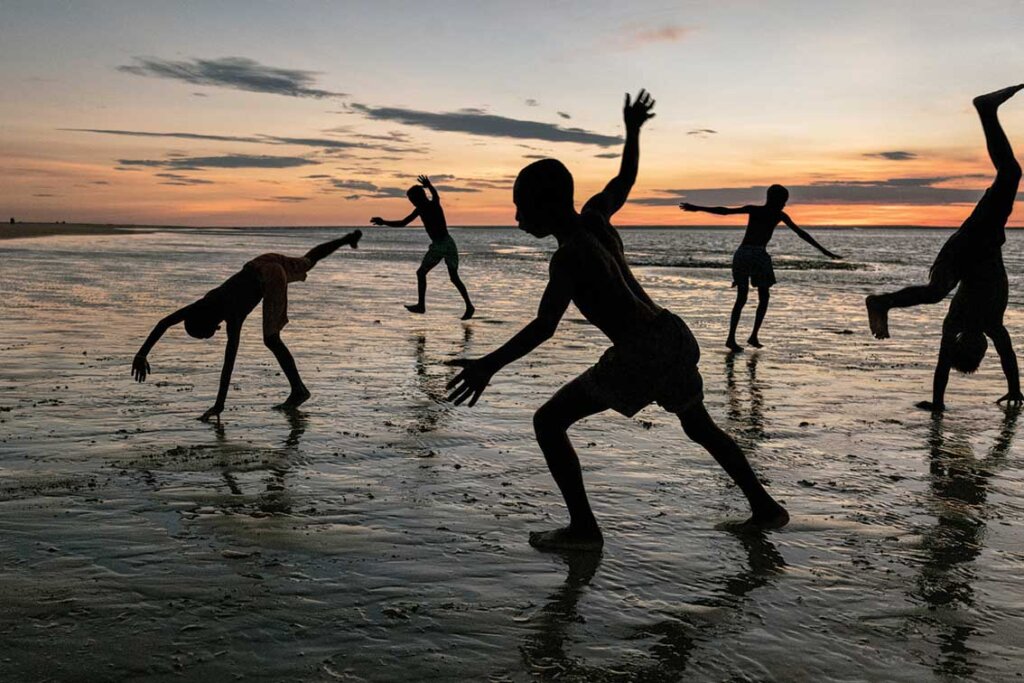
Children doing cartwheels on Belo Sur Mer beach. Morondava, Madagascar, 2019.
Children’s laughter fills the air as they somersault and cartwheel along the sandy shores, their energy mirroring the vibrant spirit of the island.
Jake Davidson ’27

The framing of the subjects, lighting and reflections in the water drew me to the photo I selected of two men walking on the side of a Venice canal. The lighting creates a mood by casting deep shadows and causing the reflections in the water below. In the water there is a mirrored image of the buildings and sidewalk above that bends and contorts the colors and lines.

I was trying to replicate the reflections in the water and the framing of the subject. I accomplished this by using reflections in the Lily Pond and the safety railing outside the Chapel – mimicking those in Venice. The safety railing frames the subject using the rule of thirds.
I learned the importance of good lighting and that you should take your time when trying to get the shot you want. You should not feel like you are in a rush when shooting.
What inspires me about the photography of Mr. McCurry is that it is timeless – the viewer has no idea when any of his images were taken. I was surprised by how images from the ’70s were indistinguishable from images from the 2010s. His work truly transcends time and language.

Man Walks Along Canal. Venice, Italy, 2011.
The city of Venice has drawn me back more times than I can count. The Italian ethos is based on living life well and to the fullest. The fascinating synergy of the people and their environment creates an endless supply of situations to photograph. Venice is a living museum that is unlike any other city in the world.

